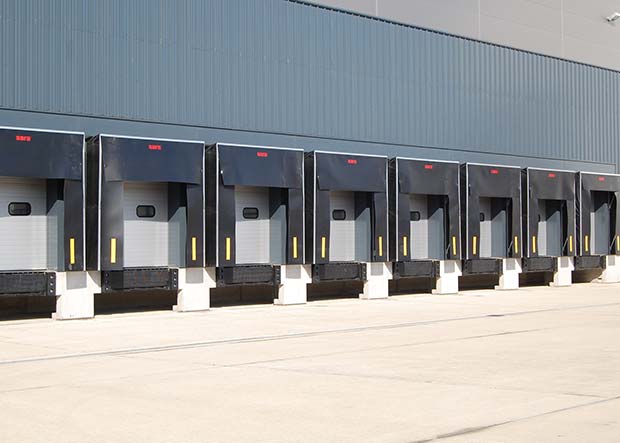Is it always necessary to fit a dock shelter to every loading bay, or can you do without and save the costs of both installation and maintenance? Nick Cox, Area Sales Manager with loading bay specialist sara LBS, looks at various options that are suitable for different applications and explains how they improve operations.
 The question: “Why go to the trouble and expense of fitting a dock shelter to your loading bay when you could go without?” has a simple answer.
The question: “Why go to the trouble and expense of fitting a dock shelter to your loading bay when you could go without?” has a simple answer.
The area is the interface between your building and the trailer or lorry being loaded or unloaded. Without a dock shelter the space would be open to the elements. So, if you fit a shelter you are going some way towards protecting your building, people and products (and hence your product quality and company reputation) from wind, rain, birds and insects.
There are several types of dock shelter available on the market, so let us review the basic designs and assess their suitability for different situations.
It is probably right to start by acknowledging that porches may provide similar protection. These are fixed devices that extend a protective roof over the apron where a truck parks – typically at a height of around a metre above the tallest trailer – and may include partial side walls. The roof will go some way to keeping product and operatives dry and the walls will help deflect wind.
However, as there is no actual seal, protection is limited, so birds and insects will not be prevented from entering the loading bay. Further, warm, cooled or filtered air may escape from the building.
In contrast, dock shelters are a low maintenance solution that physically seal the gap between the loading bay and vehicle body. Side curtains further protect goods and personnel from the weather during loading/unloading. Because the curtains actually make contact with the side and roof of the trailer, a physical barrier is created that will keep out bad weather, prevent birds from flying into the loading bay, create a barrier for airborne insects and help minimise the loss of treated air.
Both rigid and retractable dock shelters are available from sara LBS to meet specific customer needs. For rigid shelters, the frame can be galvanised steel or treated timber, and the flexible curtains can be replaced by thermally insulated panels. Standard and bespoke sizes are offered, as is a ground level shelter with a bottom seal curtain.
Retractable shelters feature a spring loaded steel frame that will retract back towards the dock if impacted by a reversing trailer, a common incident at any loading bay.
The weather seal is provided by thick PVC curtains fitted to the top and both sides. As with rigid shelters, the size of the curtains allows a touch seal to various sizes of vehicles, while an Aerolastic wind guy system maintains curtain position. Various aesthetic finishes are available to complement the appearance of the building.
Where a more robust seal is required, for example applications where thermal insulation is critical, it is possible to specify more complex shelter designs. Two options that sara LBS frequently recommend are foam filled dock pads and inflatable shelters.
The simpler solution out of the two would be the foam filled dock pads, which vehicles reverse against to form a moulded seal. sara LBS dock pads are steel backed and covered in heavy duty vinyl, options include wear pleats and yellow guide strips. This type of design offers a very good insulating seal, but is subject to limited vehicle size range and can suffer from high wear and tear.
For loading bays which need to accommodate multiple vehicle types or where traffic is extremely busy, it is often worth making the investment and specifying inflatable seals.
A fully inflatable dock shelter features a rigid frame, clad with insulated panels, incorporating side and top airbags which, when inflated, provide a compression seal around the rear of the trailer. The thickness of the bags also provide thermal insulation to prevent heat loss. sara LBS inflatable dock shelters have 0.5mm PVC storage curtains to protect the airbags, which are of machine-stitched heavy-duty PVC/polyester construction. The top airbag seal retracts automatically for maximum protection, while the side airbag seals lie flat behind the storage curtain when not in use.
The airbags are vulnerable to damage caused by vehicles reversing against the seal. As a result, sara LBS would always recommend that inflatable shelters be integrated with traffic lights, wheel guides and other vehicle control features. Once the vehicle is safely parked, inflation is performed by a motor-driven fan mounted on the underside of the roof panel and the seal is created within 10 seconds of activation.
For the ultimate in innovation sara LBS also offers a combination of inflatable and foam pad seals. The Combi-Seal offers an inflatable head bag with side pads, the design of which allows for a greater vehicle height range and maximum insulation.
So, “Why go to the trouble and expense of fitting a dock shelter to your loading bay when you could go without?”
Simple. There are a multitude of benefits found in creating a seal between the vehicle and loading bay. Hygiene, efficiency, insulation, safety are all instantly improved with a dock shelter. With such a variety of designs to choose from, it is easy to find a solution that will deliver immediate cost savings and very quickly pay for itself.
SARA




Comments are closed.